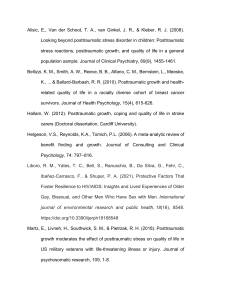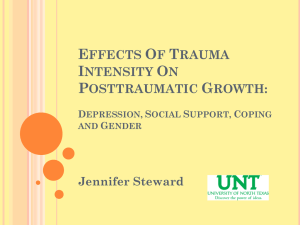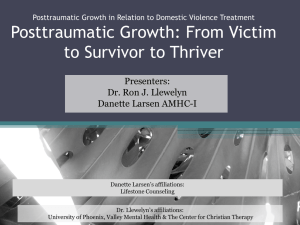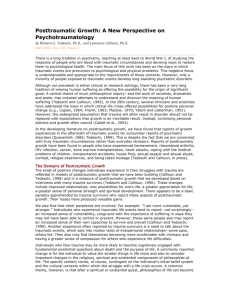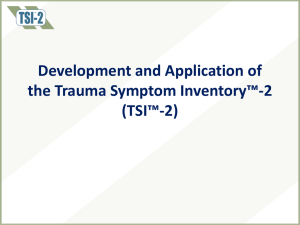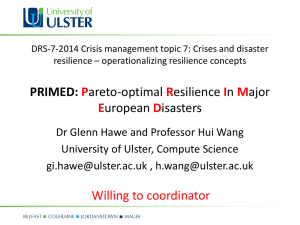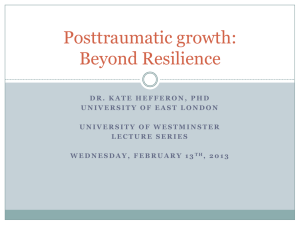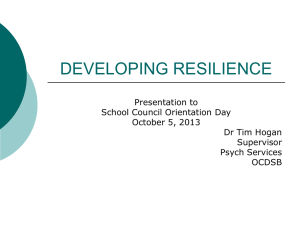Can a Healing Camp Boost Posttraumatic Growth among Children?
advertisement
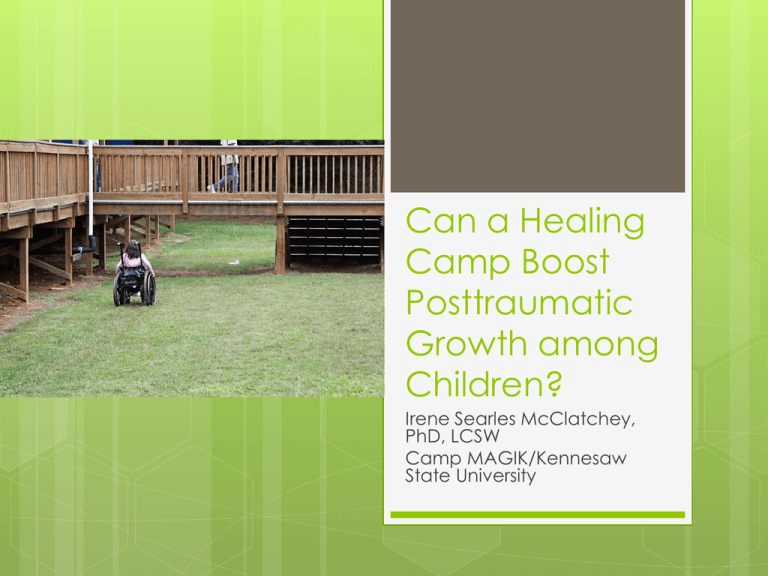
Can a Healing Camp Boost Posttraumatic Growth among Children? Irene Searles McClatchey, PhD, LCSW Camp MAGIK/Kennesaw State University Resilience Resilience – exhibited by those who do deal with a trauma without developing posttraumatic stress disorder (PTSD) symptoms Exhibit problem-solving abilities, selfesteem Sense of competence Focus on the present and the future – repressing coping style Posttraumatic Growth (PTG) Develop PTSD or PTSD symptoms Grows from the experience: New appreciation for life Sees new possibilities More compassion for others Posttraumatic Growth, cont. The trauma itself does not create PTG – it is the struggle these children experience afterwards to try to understand the experience and to accept their new reality that creates PTG (Norwegian study) Resilience and PTG in a Nutshell Resilience lets children who have experienced traumatic events to adapt well in spite of the traumatic event PTG involves a positive alteration created by the traumatic event and subsequent struggles Sample Children and adolescents ages six-18 Recruited through the school system (purposive sample) Expected losses included cancer; liver and respiratory failure; end-stage heart disease; multi-system failure (35%) Sudden or violent losses included murder; suicide; heart attacks; drowning; car accidents; and routine surgery (65%) Sample, cont. 65 campers were pre-tested using the Posttraumatic Growth Inventory for Children (PTGI-C) Gender: Males 49% Females 51% Ethnicities White 62% African American 35% Latino 3% Sample, cont. Type of loss Father 46% Mother 26% Guardian grandparent 9% Sibling 19% Age 6 – 18 Mean 11.3 (SD=2.8) Time since loss 1-48 months Mean 12.4 (SD=13.4) Instrumentation Posttraumatic Growth Inventory for Children (PTGI-C) developed by Cryder, Kilmer, Tedeschi, & Calhoun Self report Likert scale 1(Not at all true for me) 4 (Very true for me) Cronbach’s alpha 0.89 Instrumentation, cont. 21 questions, five domains New possibilities – “I have new things that I like to do” Relating to others – “I learned that some people will be there for me and help me if something bad happens” Personal strength – “I learned that I can handle my problems” Appreciation for life – “I feel like each day is important” Spiritual change – “My spiritual/religious beliefs are stronger now” The Intervention Trauma Informed Care in a Camp Setting Telling of their stories (exposure) Coping skills Relaxation and breathing exercises Cognitive restructuring Other Activities Identification of feelings Journaling Art work Traditional camp activities Results 32 campers completed the posttest (49%) Paired samples t-test Mean pre-test score=57 (SD=22.77) Mean posttest score=68.28 (SD=10.28) Statistically significant at the .05 level (p=0.013) Results, cont. Predictors of PTG using multiple regression: Objective trauma experience (p<0.01) Age only if used as a single variable (p<0.05) Limitations Design does not control for threats to internal validity (history, testing, maturation, dropout) External validity – results cannot be generalized Implications for Research and Practice Use of a controlled study Larger and more diverse sample Provide trauma-informed care to children bereaved by trauma References Brewer, J., & Sparkes, A. C. (2011). Parentally bereaved children and posttraumatic growth: Insights from an ethnographic study of a UK childhood bereavement service. Mortality, 16(3), 204-222. Brown, A. C., Sandler, I., Tein, J., Liu, X., & Haine, R. (2007). Implications of parental suicide and violent death for promotion of resilience of parentally-bereaved children. Death Studies, 31(4), 301-335. Brown, A. C., Sandler, I., Tein, J., Liu, X., & Haine, R. (2007). Implications of parental suicide and violent death for promotion of resilience of parentally-bereaved children. Death Studies, 31(4), 301-335. Cryder, C. H., Kilmer, R. P., Tedeschi, R. G., & Calhoun, L. G. (2006). An exploratory study of posttraumatic growth in children following a natural disaster. American Journal of Orthopsychiatry, 76(1), 6569. McClatchey, I. S., Barefoot, N. (2014). Can trauma-focused care improve posttraumatic growth – A pilot study. Under review.
